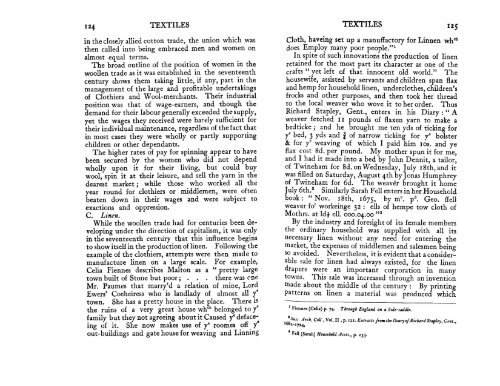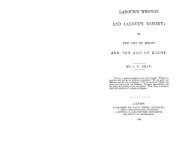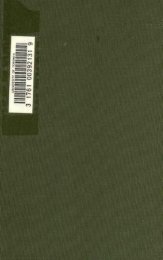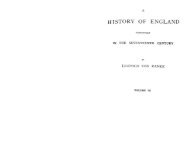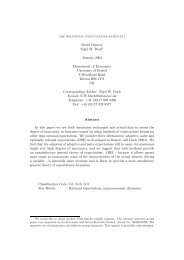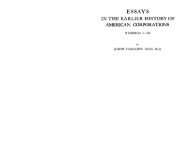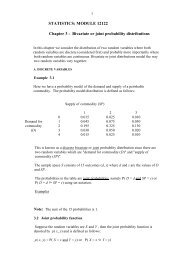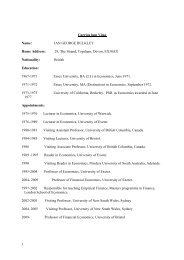124TEXTILES TEXTILESin the closely allied cotton trade, the union which wasthen called into being embraced men and <strong>women</strong> onalmost equal terms.The broad outline <strong>of</strong> the position <strong>of</strong> <strong>women</strong> in thewoollen trade as it was established in the <strong>seventeenth</strong><strong>century</strong> shows them taking little, if any, part in themanagement <strong>of</strong> the large and pr<strong>of</strong>itable undertakings<strong>of</strong> Clothiers and Wool-merchants. Their industrialposition was that <strong>of</strong> wage-earners, and though thedemand for their labour generally exceeded the supply,yet the wages they received were barely sufficient fortheir individual maintenance, regardless <strong>of</strong> the fact thatin most cases they were wholly or partly supportingchildren or other dependants.The higher rates <strong>of</strong> pay for spinning appear to havebeen secured by the <strong>women</strong> who did not dependwholly upon it for their living, but could buywool, spin it at their leisure, and sell the yarn in thedearest market ; while those who worked all theyear round for clothiers or middlemen, were <strong>of</strong>tenbeaten down in their wages and were subject toexactions and oppression.C. Linen.While the woollen trade had for centuries been developingunder the direction <strong>of</strong> capitalism, it was onlyin the <strong>seventeenth</strong> centuiy tbat this influence beginsto show itself in the production <strong>of</strong> linen. Following theexample <strong>of</strong> the clothiers, attempts were then made tomanufacture linen on a large scale.For example,Celia Fiennes describes Malton as a " pretty largetown built <strong>of</strong> Stone but poor; . . . there was cneMr. Paumes that marry'd a relation <strong>of</strong> mine, LordEwers' Coeheiress who is landlady <strong>of</strong> almost all yetown. She has a pretty house in the place. There isthe ruins <strong>of</strong> a very great house wWh belonged to yefamily but they not agreeing about it Caused ye defaceing<strong>of</strong> it. She now makes use <strong>of</strong> ye roornes <strong>of</strong>f yeout-buildings and gate house for weaving and Linningcloth, haveing set up a manuffactory for Linnen wh&does Employ many poor people."'In spite <strong>of</strong> such innovations the production <strong>of</strong> linenretained for the most part its character as one <strong>of</strong> the" yet left <strong>of</strong> that innocent old world." Thehousewife, assisted by servants and children span flaxand hemp for household linen, underclothes, children'sfrocks and other purposes, and then took her threadto the local weaver who wove it to her order. ThusRichard Stapley, Gent., enters in his Diary: " Aweaver fetched 11 pounds <strong>of</strong> flaxen yarn to make abedticke ; 2nd he brought me ten yds <strong>of</strong> ticking forye bed, 3 yds and $ <strong>of</strong> narrow ticking for ye bolster& for ye weaving <strong>of</strong> which I paid him 10s. and yeflax cost 8d. per pound. My mother spun it for me,and I had it made into a bed 'by John Dennit, a tailor,<strong>of</strong> Twineham for 8d. on Wednesday, July 18th, and itwas filled on Saturday, August 4th by Jonas Humphrey<strong>of</strong> Twineham for 6d. The weavcr brought it homeJuly 6th.' Similarly Sarah Fell enters in her Householdbook : " Nov. 18th, 1675, by m". pd. Geo. Bellweaver for workeinge 32 : ells <strong>of</strong> hempe tow cloth <strong>of</strong>Mothrs. at Id+ ell. ooo.04.00 "3By the industry and foresight <strong>of</strong> its female membersthe ordinary household was supplied with all itsnecessary linen without any need for entering themarket, the expenses <strong>of</strong> middlemen and salesmen beingso avoided. Nevertheless, it is evident that a considerablesale for linen had always existed, for the linendrapers were an important corporation in manytowns. This sale was increased through aninventi~nmade about the middle <strong>of</strong> the <strong>century</strong> : By printingpatterns on linen a material was produced which' Fiennes (Celia) p. 74.Pbrougb England on a S&-saddle.'Suss Arch. Col1 , Vol. I1 ,p. rzr. Extracts frmtbeDaary<strong>of</strong>Ricbard Stapley, Gent.,1682-1~2%a ell (Sarah) Hmuebold Accts., p. 233.
126 TEXTILES TEXTILESclosely imitated the costly muslins, or calicoes asthey were then called, imported from India ; but atso reasonable a price that they were within the reach <strong>of</strong>a servant's purse. Servants were therefore able to goout in dresses scarcely distinguishable from theirmistresses', and the sale <strong>of</strong> woollen and silk goods wasseriously affected. The woollen trade became alarmed ;riots took place ; weavers assaulted <strong>women</strong> who werewearing printed linens in the streets, and finally,Parliament, always tender to the woollen trade,which furnished so large a part <strong>of</strong> the national revenue,prohibited their use altogether. The linen printersrecognising that " the Reason why the English Manufacture<strong>of</strong> linnen is not so much taken notice <strong>of</strong> as theScotch or Irish, is this, the Englzsh is mostly consumedin the Country, . . . whereas the Scotch and Irishmust come by sea and make a Figure at our custom'shouse,"' urged in their defence that " the linensprinted are chiefly the Growth and Manufacture <strong>of</strong>North Britain pay gd. per Yard to the Crown, . . .and Employ so many Thousands <strong>of</strong> British poor, aswill undoubtedly entitle them to the Care <strong>of</strong> a BritishParliament.""But even this argument was unavailing against thepolitical influence <strong>of</strong> the woollen trade. The spirit<strong>of</strong> the time favouring the spread <strong>of</strong> capitalistic enterprisefrom the woollen trade into other fields <strong>of</strong> action,an attempt was now made to form a Linen Company.Pamphlets written for and against this project furnishmany details <strong>of</strong> the conditions then prevailingin the manufacture <strong>of</strong> linen. " How," it was said,will the establishment <strong>of</strong> a Linnen Company "affectthe Kingdom in the two Pillars that support it, that<strong>of</strong> the Rents <strong>of</strong> Land and the imploying our Shipsand Men at Sea, which are thought the Walls <strong>of</strong> the1 Case <strong>of</strong> Brrtzsb and Zrrrb Manujacturc <strong>of</strong> Lznncn.Case <strong>of</strong> tbe Lznen Drapers.Nation.127For the Rents <strong>of</strong> Land they must certainlvfall, for that one Acre <strong>of</strong> Flax will inlploy as manyHands the year round, as the Wool1 <strong>of</strong> Sheep thatgraze twenty Acres <strong>of</strong> Ground. The Linnen Manufactoryimploys few men, the Woollen most, Weaving,Combing, Dressing, Shearing, Dying, etc. These Eatand Drink more than Women and Children ; and soas the Land that the Sheep gaze on raiseth the Rent.so will the Arable and Pasture that bears Corn, andbreeds Cattle for their Subsistence. Then for theEmployment <strong>of</strong> our Shipping, it will never be pretendedthatwe can arrive to Exportation <strong>of</strong> Linnen ; thereare others and too many before us in that. . . . ThatProjectors and ourt tiers shoulil be inspired withNew Lights, and out <strong>of</strong> love to the Nation, createnew Methods in Trades, that none before found out ;and bp inclosing Commons the Liberty <strong>of</strong> Trade intoShares, in the first place for themselves, and then forsuch others as will pay for both, is, I must confess,to me, a Mystery I desire to be a Stranger unto . . .The very Name <strong>of</strong> a Company and Joint-Stock inTrade, is a spell to drive away, and keep out <strong>of</strong> thatplace where they reside, all men <strong>of</strong> Industry. . . .The great motive to Labour and Incouragement <strong>of</strong>Trade, is an equal Freedom, and that none may besecluded from the delightful Walks <strong>of</strong> Liberty . . .a Subjection in Mnnufactories where a People areobliged to one Master, rho' they hale the full Value<strong>of</strong> their Labour, is not pleasing, they think themselvesin perpetual Servitude, and so it is obserk ed in I?rlnnd,where the 1rt.h made a Trade <strong>of</strong> Linnen Yarn, noMan could ingage them, hut thev would go to theMarket and be better satisfied with a less price, thanto be obliged to one master. . . . There wasmuch more Reason for a Company and Joint-stock'0 set up the Woollen Manufa~tor~, in that ignorantAge, than there is for this <strong>of</strong> the Linnen Manufactorv ;that <strong>of</strong> the Woollen was a new Art not known in this
- Page 1 and 2:
WORKING LIFE OF WOMENIN THESEVENTEE
- Page 6 and 7:
4 INTRODUCTORYtragic class of wage
- Page 8 and 9:
8 INTRODUCTORY INTRODUCTORYDomestic
- Page 10 and 11:
INTRODUCTORYunmarried girls go out
- Page 12 and 13:
I 6 CAPITALISTS CAPITALISTS" I loos
- Page 14 and 15:
CAPITALISTSweak woman stands in the
- Page 16 and 17: 24 CAPITALISTS CAPITALISTS 25wife t
- Page 18 and 19: 2 8 CAPITALISTS CAPITALISTS 29Majes
- Page 20 and 21: 32 CAPITALISTSA warrant was issued"
- Page 22 and 23: CAPITALISTSbusiness. " At O~tend, N
- Page 24 and 25: CAPITALISTS CAPITALISTS41thro' her
- Page 26 and 27: AGRICULTUREwas made of their develo
- Page 28 and 29: AGRICULTUREis not drye as it should
- Page 30 and 31: 52 AGRICULTURE AGRICULTUREhave of h
- Page 32 and 33: 56 AGRICULTUREfor colonists in Virg
- Page 34 and 35: AGRICULTUREmaintain completely the
- Page 36 and 37: 64 AGRICULTUREtime was well spent i
- Page 38 and 39: AGRICULTUREExcept in exeptional cir
- Page 40 and 41: 72 AGRICULTURE AGRICULTURE 73mainta
- Page 42 and 43: 76 AGRICULTUREfor the impotent poor
- Page 44 and 45: AGRICULTUREwhich we can imagine tha
- Page 46 and 47: AGRICULTURE AGRICULTURE 85by his se
- Page 48 and 49: AGRICULTUREher work, but generosity
- Page 50 and 51: AGRICULTUREwife of Thos. Lyne. Toba
- Page 52 and 53: TEXTILESwas paid better than the la
- Page 54 and 55: TEXTILESroof provided them with the
- Page 56 and 57: 104 TEXTILESformulated by 25 Charle
- Page 58 and 59: 108 TEXTILES TEXTILES 109until the
- Page 60 and 61: TEXTILESon spinning for their livin
- Page 62 and 63: TEXTILESstill and dry within Doors,
- Page 64 and 65: 120 TEXTILES TEXTILESthe cloth made
- Page 68 and 69: TEXTILESKingdom, it required a grea
- Page 70 and 71: 132 TEXTILES TEXTILESnot exceedl6 1
- Page 72 and 73: TEXTILES TEXTILES I37hours in four
- Page 74 and 75: ---P-I 4OTEXTILEScan be quoted of t
- Page 76 and 77: '44 TEXTILES TEXTILESWood Streate,
- Page 78 and 79: TEXTILEShigher wages than would hav
- Page 80 and 81: 1 52 CRAFTS AND TRADESdebts. For ex
- Page 82 and 83: I 56 CRAFTS AND TRADES CRAFTS AND T
- Page 84 and 85: 160 CRAFTS AND TRADES CRAFTS AND TR
- Page 86 and 87: 164 CRAFTS AND TRADESAmong thirty-n
- Page 88 and 89: CRAFTS AND TRADESalso met with as b
- Page 90 and 91: 172 CRAFTS AND TRADES CRAFTS AND TR
- Page 92 and 93: 176 CRAFTS AND TRADESto Henry Joyce
- Page 94 and 95: 180 CRAFTS AND TRADES CRAFTS AND TR
- Page 96: CRAFTS AND TRADESWardens and Brothe
- Page 99 and 100: P-I9OCRAFTS AND TRADESmarriage ; it
- Page 101 and 102: CRAFTS AND TRADEStaken our goods fr
- Page 103 and 104: 1g8CRAFTS AND TRADESresources turne
- Page 105 and 106: CRAFTS AND TRADESThere were fewer r
- Page 107 and 108: 206 CRAFTS AND TRADES CRAFTS AND TR
- Page 109 and 110: CRAFTS AND TRADESA large proportion
- Page 111 and 112: 214CRAFTS AND TRADES CRAFTS AND TRA
- Page 113 and 114: 218 CRAFTS AND TRADES CRAFTS AND TR
- Page 115 and 116: 222 CRAFTS AND TRADES CRAFTS AND TR
- Page 117:
CRAFTS AND TRADES CRAFTS AND TRADES
- Page 120 and 121:
CRAFTS AND TRADESfrom her fellow pa
- Page 122 and 123:
PROFESSIONS 237PROFESSIONSIntroduct
- Page 124 and 125:
24O PROFESSIONS PROFESSIONStheir Th
- Page 126 and 127:
244 PROFESSIONS PROFESSIONS 245the
- Page 128 and 129:
PROFESSIONS PROFESSIONS 249profanat
- Page 130 and 131:
252PROFESSIONSGiles Moore enters in
- Page 132 and 133:
PROFESSIONScribed as one who " dist
- Page 134 and 135:
PROFESSIONS PROFESSIONS 261first ma
- Page 136 and 137:
264 PROFESSIONSGarrett's leg shall
- Page 138 and 139:
268 PROFESSIONSwhere there are none
- Page 140 and 141:
PROFESSIONS PROFESSIONS 273the numb
- Page 142 and 143:
PROFESSIONSexaminations, before six
- Page 144 and 145:
PROFESSIONS PROFESSIONS 281death me
- Page 146 and 147:
284 PROFESSIONS PROFESSIONSof confi
- Page 148 and 149:
288 PROFESSIONSextent they were whe
- Page 150 and 151:
CONCLUSIONor in her other facilitie
- Page 152 and 153:
CONCLUSION CONCLUSION 297in women's
- Page 154 and 155:
CONCLUSIONlaw of Nature, inviolable
- Page 156 and 157:
CONCLUSIONwere specially deprecated
- Page 158 and 159:
308 CONCLUSIONof the State, and the
- Page 160 and 161:
312 AUTHORITIES AUTHORITIES 313Cost
- Page 162 and 163:
AUTHORITIESMartindale, Adam, The Li
- Page 164 and 165:
County.Buckingham ..Cardigan .. ..C
- Page 166 and 167:
INDEXINDEXFlax, 64, 146, 246, 291 ;
- Page 168:
INDEXsmants, women( 50,65,157 ; mam


